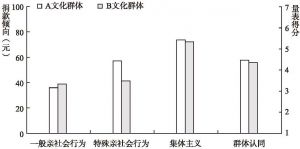论文
集体主义与亲社会行为:群体认同的作用
摘要
从进化的视角来看,集体主义强调人际互依与社会责任,因而会促进亲社会行为。然而,近来的跨文化研究发现,生活在集体主义社会的个体表现出较低的亲社会倾向,这挑战了经典的理论,也暗示集体主义与亲社会行为的关系背后可能有一些深层的社会心理因素有待检验。本研究基于决策游戏任务,探讨了两个不同文化群体的集体主义和亲社会行为以及群体认同的作用。结果发现:一般亲社会行为、集体主义与群体认同上均无显著的群体差异,但是特殊亲社会行为存在显著的群体差异,且群体认同在集体主义与特殊亲社会行为之间存在有调节的中介作用。本研究揭示了集体主义与亲社会行为关系的群体一致性和差异性——尽管总体而言中国人表现出一致的集体主义和亲社会倾向,但不同群体的集体主义对亲社会行为有不同的作用路径,集体主义更可能对群体身份相关的特殊亲社会行为起到促进作用,而对指向陌生人的一般亲社会行为作用很有限。
作者
吴胜涛 ,厦门大学社会与人类学院副教授,硕士生导师,通信作者,E-mail:commuagent@163.com或michaelstwu@xmu.edu.cn
高承海 ,西北师范大学西北少数民族教育发展研究中心(教育部人文社会科学重点研究基地)副教授,硕士生导师,通信作者,E-mail:gaochenghai@163.com
梁肖幸子 ,厦门大学新闻传播学院本科生。
胡沈璠 ,厦门大学新闻传播学院本科生。
Wu Shengtao
Gao Chenghai
Liangxiao Xingzi
Hu Shenfan
检索正文关键字
论文目录
-
一 引言
- (一)集体主义与亲社会行为
- (二)文化与群体认同
- (三)研究问题与假设
-
二 方法
- (一)被试
- (二)研究工具
- 三 结果
- 四 讨论
查看更多>>>




